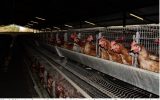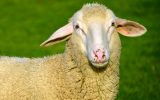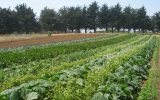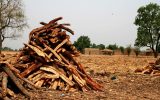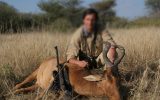In Otjozondjupa region, Otjiwarongo district there is a phenomenal farm that goes by the name of Drukwerk. The farm is exactly 24 km from Otjiwarongo situated on the left side of the road. The farm parallel with the road and the distance from the road to the farm compound is 8 Km. Anita Jooste is the head of operation on the farm and she have been farming with the Santa Gertrudis cattle breed on a full time basis since 2005. Jooste is an architecture by profession, however since 2005, she deviated her attention from her career towards a more full time farming profession.
Santa Gertrudis breed
The Santa Gertrudis breed are mostly red and their colour is very dominant. In case, where they cross breed with other breeds, their colour often comes out victorious. The breed is very well adapted to the Namibian climate. The Drukwerk farm consists of about 30 camps. Matured cows and bulls are kept in the same camp, ensuring that they get calves throughout the entire year. The heifers that are still young and developing are kept in a separate camp and so does the rest of the bulls that are less than 3 years. A bull only gets to join the herd of the cows as from 3 years, since that`s the time is mature and well developed. The Drukwerk farm manages their grazing pastures by moving and rotating the cattle’s in these camps from time to time. Dividing the farm in camps, is not only good for pasture management but it`s also good to manage the cattle’s in general. In regard with the heifers, it’s important that they reaches a certain size of development before they start breeding with the bulls. According to Jooste, the heifers should at least be weighting 300 kg before the mating season.
Why farm with a Santa Gertrudis breed?
For farmers that raises cattle, farming with a Santa Gertrudis breed should be one of the high priority on their list. Firstly, the breed is well adaptable in the sense that they will suit almost to any and every farm. The breeds are adapted to living under harsh environmental conditions and they are known to fatten well under natural grazing and also in the feedlots. The cows are excellent mothers and they are known to be very protective over their calves. The cows often breed small calves for easy calving however afterwards, their calves happens to grow very fast. The breed can be well tamed, making it easier and suitable to work with people. The Gertrudis is a heavy breed and have a strong bone structure. For the last years, when the country was going through the disastrous drought, the Santa Gertrudis breed showed resistance to the unfavourable changes that occurred in the environment. They were fast at adopting to the drought condition and although they got frail, they weathered through the storm.
A typical day on the farm
According to Jooste their day normally starts at 08:00, during this time she gets to meet up with her team and they then discuss over the tasks that have to be carried out on that specific day. Once they have a clear picture of what is expected of them, they then take off to execute their tasks. Activities includes; going to the watering points and giving some licks to the cattle’s. It is also during this time that they observe if the cattle’s are in good condition or if whether they face some health challenges.
“From watering points to more inspection in the field”.
Afterwards, the team then goes into the field and see that the fencing is in good condition and it haven`t fallen or trampled down. The team also gets to observe if whether the cows have gotten new calves. If it happens that the cows have gotten new calves, they will inspect the health condition of the calves. The calves will then be collected from the field and they will be transported to a safe compound stall near the farm, where new born calves are kept. It is very critical to collect the small calves from the field as there are predators out there such as: the brown hyenas, leopards and cheetahs.
Expenses on the farm
According to Jooste, her fixed expenses are the salaries of the staffs, fuel (diesel), electricity and licks for the animals. There is also other unforeseen expenses that often comes unannounced such as; car break down, pipe burst and repair of water pumps if there is a fault.
To have happy & healthy cattle’s, you must look after them
Jooste have clearly emphasised that, for one to have happy and healthy cattle’s, one needs to look after them. Hence in summer, they often give their cattle a phosphate lick and in winter they get a winter lick. Jooste says that, she loves adding molasses into the licks, ensuring that the cows and the calves have more energy. Every day, they look after their cattle to ensure that they are in good health. Inspecting if there is anything stuck among the hoofs of the cattle and inspection of their eyesight are among few of the inspection that occurs on a daily basis. About twice a year, they deworm their cattle’s. Deworming cattle’s is good in the fight against parasites. In addition, they do also inject their cattle’s with Vitamin A, as it is critical for good vision, normal reproduction, healthy mucous membranes and to promote skeletal growth.
Challenges on the farm
During 2018 & 2019 when the disastrous severe drought was ongoing, the challenge was to ensure that the cattle gets feeds and survive. During this period, the Drukwerk farm had to sell a lot of their cattle’s (destocking). By this time, they were always on the move from the north to the west, renting farms and places just for their cattle’s to get enough feed. According to Jooste, the movement process of the cattle was quite expensive and challenging considering that they also had to move the little calves. The painful moment is that, during the re-allocation period, most of their calves died.
The challenge now on the farm is to keep as much calves as they can alive, from predators. Normally, predators don`t prey on calves however when small calves are in the field, they become easy picking. In order to counteract this challenge, they often keeps the small calves near the house or farm compound rather than letting them to roam out there in the field. Keeping the calves nearby the house is not always easy, however with this year’s rainfall, with all the good grass surrounding the house; it`s possible. Once the calves turn 2 months, they go through the dehorning process. After 3 months, the burden of monitoring and giving too much attention to the calves gets to decrease, as by this point they are starting to become more independent and they often fend for themselves. Lastly, one of the challenges that the Drukwerk farm goes though is cattle theft. Although it occurs on rare cases, it happens that thieves’ breaks in the farm during night time, attack the cattle in the field, kill one or two and they then drive away with the entire carcass. Updating more of their security features on the farm is the only way, they get to overcome cattle theft.
The weaning process
At Drukwerk farm, there are 2 considerations that comes into play before weaning the calves, namely: what time of the year it is and the size of the calf. Jooste says that they start weaning the calves, when they are about 7 months. They separate all the weaners and inspect them for health related conditions. Once they have separated the weaners, for the first two weeks they put the calves in a camp next to their mothers, however not in the same camp. This ensures that for calves that are still desperately in need of the mother’s milk, they will get to suckle through the fence. This is a technique to gradually wean the calves from their mothers. After the 2 weeks, the calves are then completely separated from their mothers and placed in a different camp were they do not have any attachment with their mothers.
During this time, the weaners are injected with Supavax and given a multivitamin. At this point, all this is critical because the weaners happens to go through a shock as they are no more with their mothers. It`s also during this point that they deworm the weaners, give them some licks until they are big enough to go to an auction or to stay in the camp and become breeding bulls or cows.
Record keeping on the farm “The Black Book”
Record keeping is an important aspect in managing a farm. Accurate record keeping is an essential part of good cattle management. To keep records means to collect relevant information that can help you to keep track of activities taking place on the farm. Records should be simple and systematic. Jooste keeps record of the variety of activities that are happening on the farm in a “black book”. Firstly, manually in her black book and then at a later stage, she will update them electronically on the computer. Jooste says that, when you are on the move and about in the field, it is easier to record what is happening manually on the book and update it later on the computer. In her record keeping, she keeps record of items such as the camping system and how she will be rotating the cattle within the camps. Record keeping are also kept for the number of cattle in the camps, their calves and the date by which the calves are born. In the first two days when the calves are born, their weigh will be recorded down, who their mother is and the bull that fathered the calves will also be noted down. In the end, when it is weaning time, they will know exactly the number of calves present and specifically which calves are bulls and which one are heifers. The time that the bulls mate with the cows are also noted down, to find out during the birth of the calves if whether it was born on time, early or too late. Record keeping is very important as it makes it easier to notice of any changes in the number of cattle or calves and it`s just good for managing the herds.
The feeding process
According to Jooste, the licks that they feed their cattle is standardised and they do not feed their cattle licks on a full time basis let they fattened or so. Jooste emphasised that the cattle have to go in the field, feed on the grass and sort things out for themselves. The licks that they give to their cattle is only a supplement. Therefore a winter lick and a phosphate lick in summer is recommended. There is always a salt lick on the farm and in the camps. Protein licks is often more given to the bulls before they head off to the auction, the protein licks enables the bulls to be in good physique and stature.
Message to take home
At the Drukwerk farm, they do also have a variety of beautiful turkeys. For the bird lovers and those that love turkeys can contact Jooste. Anita believes that at the ultimate of one`s farming activities, one must love what they do, love their cattle, look after their farm and maintain their place very well.” Anita further encouraged the attitude of learning from others. In her own words “learn from those that got the skills, ask questions, never adopt the attitude of you know it all, hence ask people that are better breeder, those that have better pastures, consultants and ground specialists”. Jooste ends by saying, “we are never too old to learn & therefore we should learn from others and thank God everyday”.
For those that would love to farm with this heavy breeds that is resistant to diseases and adaptable to the Southern Climate, they can contact Anita Jooste at Cell: +26481 261 1281 Email: ajooste@iway.na





